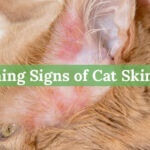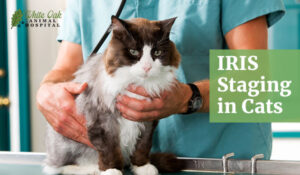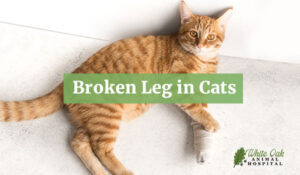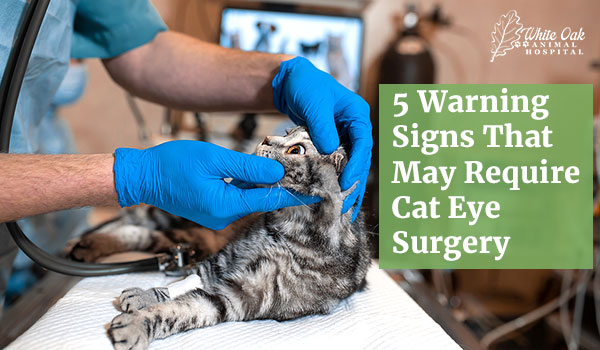
Cat eye surgery can be life-saving when severe eye conditions threaten your cat’s vision. A cat’s eyesight is essential for movement, hunting, and interacting with its surroundings. When eye problems arise, they can lead to discomfort, disorientation, or even blindness. Detecting these issues early and seeking veterinary care can help prevent permanent damage.
Certain eye conditions require immediate medical attention. Cat eye surgery may sometimes be the best option to restore vision and relieve pain. Timely intervention can prevent infections from spreading and stop the condition from worsening. Dr. Damron can determine the most effective treatment to protect your cat’s eyesight.
Clear signs indicate when a cat’s eyes may be at risk. These symptoms can range from excessive tearing to sudden vision loss. Understanding these warning signs can help pet owners decide when professional care is needed, including the possibility of cat eye surgery. Recognizing these symptoms early can significantly affect your cat’s quality of life.
5 Critical Warning Signs Your Cat May Need Cat Eye Surgery
1. Persistent Squinting or Blinking
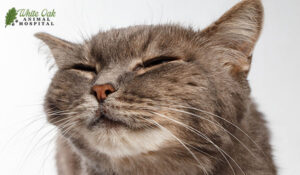 Cat eye surgery may be necessary if your cat is squinting or blinking excessively. Squinting can indicate pain or irritation caused by an infection, injury, or an underlying eye condition. If your cat keeps one or both eyes partially closed, it may be trying to protect itself from discomfort. When squinting lasts more than a day, it’s best to have Dr. Damron check for serious issues.
Cat eye surgery may be necessary if your cat is squinting or blinking excessively. Squinting can indicate pain or irritation caused by an infection, injury, or an underlying eye condition. If your cat keeps one or both eyes partially closed, it may be trying to protect itself from discomfort. When squinting lasts more than a day, it’s best to have Dr. Damron check for serious issues.
Several conditions can cause persistent squinting. Corneal ulcers, painful open sores on the eye, can make your cat highly sensitive to light. Glaucoma, a condition that increases pressure in the eye, can also lead to excessive blinking and vision loss. Cat eye surgery is sometimes needed to remove foreign objects or repair damage to the cornea.
Cats instinctively hide their pain, so even mild squinting should not be ignored. If your cat is also rubbing its eyes, tearing up, or avoiding bright lights, there may be an underlying problem. Delaying treatment can lead to infections or worsening conditions that may require more invasive procedures. A veterinary exam can determine if medication or surgery is the best option for your pet.
If squinting happens suddenly or worsens over time, don’t wait to seek help. Eye conditions can progress quickly, leading to complications or permanent damage. A veterinarian can diagnose the problem and recommend the proper treatment. In cases where medication is not enough, cat eye surgery can help restore your cat’s vision and comfort.
2. Cloudy or Hazy Eyes
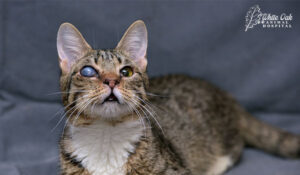 If your cat’s eyes look cloudy or hazy, it could be a sign of a serious condition. Cataracts, corneal ulcers, and infections are common causes of eye cloudiness. These issues can make it harder for your cat to see and may worsen over time. Cat eye surgery is sometimes the best way to restore clear vision and prevent further complications.
If your cat’s eyes look cloudy or hazy, it could be a sign of a serious condition. Cataracts, corneal ulcers, and infections are common causes of eye cloudiness. These issues can make it harder for your cat to see and may worsen over time. Cat eye surgery is sometimes the best way to restore clear vision and prevent further complications.
Cloudy eyes can develop slowly or appear suddenly. Cataracts, often seen in older cats, can block light from reaching the retina, leading to gradual vision loss. Corneal ulcers, caused by injuries or infections, create a cloudy film over the eye and can be very painful. When medication is insufficient, cat eye surgery may be needed to remove cataracts or repair severe corneal damage.
Without treatment, cloudy eyes can lead to blindness. Your cat may bump into objects, misjudge distances, or become less active. If left untreated, the eye may become inflamed or permanently damaged. Dr. Damron can determine if surgery or another treatment is necessary to save your cat’s vision and can provide a referral to a veterinary ophthalmologist if needed.
If you notice changes in your cat’s eyes, don’t wait to seek help. Eye conditions can progress quickly, making early treatment crucial. A veterinary exam can identify the cause and provide the best care plan. Cat eye surgery can significantly improve your cat’s sight and overall quality of life.
3. Excessive Tearing or Eye Discharge
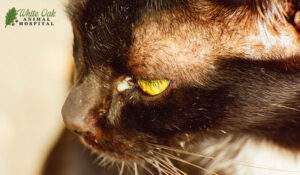 If your cat’s eyes are constantly watery or producing discharge, it may indicate an underlying issue. Infections, blocked tear ducts, and conjunctivitis are common causes of excessive tearing. Clear discharge may indicate allergies or mild irritation, while thick mucus or pus often signals an infection. When these problems persist, cat eye surgery may be needed to clear blockages or prevent further damage.
If your cat’s eyes are constantly watery or producing discharge, it may indicate an underlying issue. Infections, blocked tear ducts, and conjunctivitis are common causes of excessive tearing. Clear discharge may indicate allergies or mild irritation, while thick mucus or pus often signals an infection. When these problems persist, cat eye surgery may be needed to clear blockages or prevent further damage.
Not all eye discharge is a cause for concern, but persistent or worsening symptoms should not be ignored. A watery discharge that turns thick, yellow, or green may indicate a severe infection. Tears may overflow and irritate the eyes if the tear ducts are blocked. In cases where medical treatment is not enough, cat eye surgery can help restore proper drainage and prevent long-term discomfort.
Chronic eye infections can lead to scarring, making it harder for your cat to see. Some infections spread deeper into the eye, causing pain and increasing the risk of blindness. If your cat frequently rubs its eyes or squints, it may be trying to relieve discomfort. Dr. Damron can determine if surgery is the best option to remove obstructions or repair damage.
If you notice ongoing discharge, don’t wait for the condition to worsen. Early treatment can prevent complications and keep your cat comfortable. A veterinary exam will help identify the cause and the most effective solution. Cat eye surgery may be the best way to protect your cat’s vision and eye health in severe cases.
4. Swelling Around the Eye
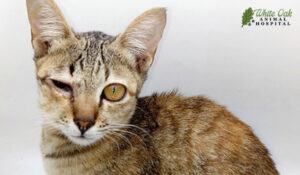 If your cat has swelling around its eye, it could be a sign of a serious issue. Trauma, infections, abscesses, or even tumors can cause swelling that affects vision and comfort. Mild swelling may disappear with medication, but persistent or worsening symptoms need veterinary attention. Cat eye surgery is sometimes necessary to remove growths, drain abscesses, or repair damage.
If your cat has swelling around its eye, it could be a sign of a serious issue. Trauma, infections, abscesses, or even tumors can cause swelling that affects vision and comfort. Mild swelling may disappear with medication, but persistent or worsening symptoms need veterinary attention. Cat eye surgery is sometimes necessary to remove growths, drain abscesses, or repair damage.
Swelling can make it difficult for your cat to keep its eye open. It may also lead to pain, redness, and sensitivity to light. If an infection is causing the swelling, it can spread and put your cat’s vision at risk. Cat eye surgery may be required to prevent complications when swelling is severe or does not improve with treatment.
Some causes of swelling, like tumors or deep infections, do not improve on their own. A growing mass can press on the eye, leading to discomfort and vision loss. If your cat’s eye looks swollen for over a day, it must be examined.
Ignoring eye swelling can lead to long-term problems. Early treatment can reduce pain and help save your cat’s vision. A veterinary exam will identify the cause and the most effective treatment. Cat eye surgery can help restore your cat’s comfort and eye health when medication is not enough.
5. Red or Inflamed Eyes
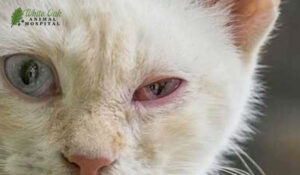 If your cat’s eyes look red or irritated, it could indicate a serious condition. Conjunctivitis, uveitis, and glaucoma are common causes of eye inflammation in cats. Mild redness may worsen with medication, but persistent or worsening symptoms need veterinary care. Cat eye surgery may be necessary in severe cases to relieve pain and protect your cat’s vision.
If your cat’s eyes look red or irritated, it could indicate a serious condition. Conjunctivitis, uveitis, and glaucoma are common causes of eye inflammation in cats. Mild redness may worsen with medication, but persistent or worsening symptoms need veterinary care. Cat eye surgery may be necessary in severe cases to relieve pain and protect your cat’s vision.
Red or swollen eyes can make your cat uncomfortable. You may notice excessive blinking, pawing at the eye, or sensitivity to light. Inflammation can also cause discharge, making it harder for your cat to open its eyes. When medications are not enough to reduce swelling and pain, cat eye surgery can help address the underlying issue.
Some eye conditions, like glaucoma, worsen quickly and require urgent care. Increased pressure in the eye can lead to permanent vision loss if left untreated. If your cat’s eyes remain red despite treatment, an internal problem may need surgical correction. Dr. Damron can determine if cat eye surgery is the best option for long-term relief and provide a referral if necessary.
Ignoring persistent redness can put your cat’s eyesight at risk. Early intervention can prevent discomfort and stop the condition from worsening. A veterinary exam will help identify the cause and the most effective treatment. Cat eye surgery is sometimes the best way to restore your cat’s eye health and overall well-being.
When Is Cat Eye Surgery Necessary?
Cat eye problems can range from mild infections to severe conditions requiring surgery. Some issues, like cataracts, corneal ulcers, and tumors, may not respond to medication alone. Cat eye surgery may be the best option for vision loss, chronic pain, or severe infections. A veterinarian can assess your cat’s condition and recommend the right treatment plan.
There are different types of cat eye surgery, depending on the issue. Cataract removal can restore vision, while corneal repair or cherry eye surgery can relieve discomfort. In severe cases, enucleation—eye removal—may be necessary to prevent further pain and complications. Each procedure is performed under anesthesia and followed by a recovery period with medication and care.
Veterinarians decide if surgery is needed based on the severity of the condition. They may recommend it when other treatments, like eye drops or antibiotics, do not work. Diagnostic tests, such as eye pressure measurements and imaging, help determine the best approach. If surgery is required, early intervention can improve success rates and help maintain your cat’s quality of life.
 Most cat eye surgeries have high success rates when performed by experienced veterinarians. Cataract removal, for example, has a success rate of over 90%. After surgery, post-op care is essential to ensure proper healing. With the right treatment and follow-up care, many cats regain their vision and return to a comfortable, active life.
Most cat eye surgeries have high success rates when performed by experienced veterinarians. Cataract removal, for example, has a success rate of over 90%. After surgery, post-op care is essential to ensure proper healing. With the right treatment and follow-up care, many cats regain their vision and return to a comfortable, active life.
Caring for your cat’s eye health is essential to maintaining their well-being. Eye conditions can worsen quickly, leading to pain, vision loss, or even blindness. Cat eye surgery may be necessary to restore vision and relieve discomfort when medications are insufficient. Seeking professional care early can significantly improve your cat’s quality of life.
At White Oak Animal Hospital, your cat will receive expert care from a team with over 28 years of experience treating complex eye conditions. Our hospital provides both traditional treatments and integrative options not available elsewhere. With TCVM Telemedicine consultations, we offer holistic approaches that complement standard veterinary care. We are committed to finding the best solution for your pet’s needs.
Frequently Asked Questions
How can I tell if my cat’s eye problem is an emergency?
If your cat’s eye is swollen shut, bleeding, or has a sudden change in appearance, it may be an emergency. Severe pain, excessive tearing, or difficulty keeping the eye open also require immediate attention. If your cat bumps into objects or appears disoriented, vision loss could progress quickly. When in doubt, seek veterinary care as soon as possible.
Can a cat’s eye heal without surgery?
Some minor eye issues, like mild infections or irritations, can heal with medication and proper care. However, more serious conditions—such as deep corneal ulcers, advanced cataracts, or tumors—may not improve without surgical intervention. Cat eye surgery may be the best option if the problem is not resolved with prescribed treatment. A veterinarian can determine if surgery is necessary.
How long does it take for a cat to recover from eye surgery?
Recovery time depends on the type of cat eye surgery performed. Most cats heal within two to six weeks, but some may need extended care. Your cat may need an Elizabethan collar (cone) to prevent scratching, special eye drops, or medication to aid healing. Following your veterinarian’s aftercare instructions is key to a smooth recovery.
Related Posts
-
Easy Cat UTI Prevention
Cat UTI prevention is simple once you understand the root cause. Your veterinarian can help…
-
5 Alarming Signs of Cat Skin Cancer: Early Detection is Key
The importance of early detection in managing cat skin cancer cannot be overstated. As pet…
-
Facts About Cat Kidney Failure
If your pet experiences any symptoms of cat kidney failure, immediately take them to your…
-
Eastern and Western Cat Cancer Treatments
As cats age, they often get lumps and bumps.In veterinary medicine, these are called masses…


